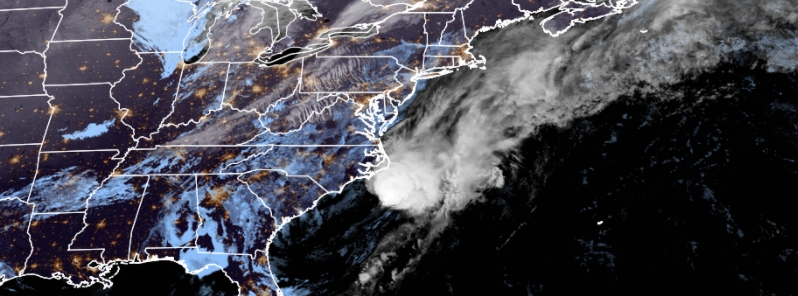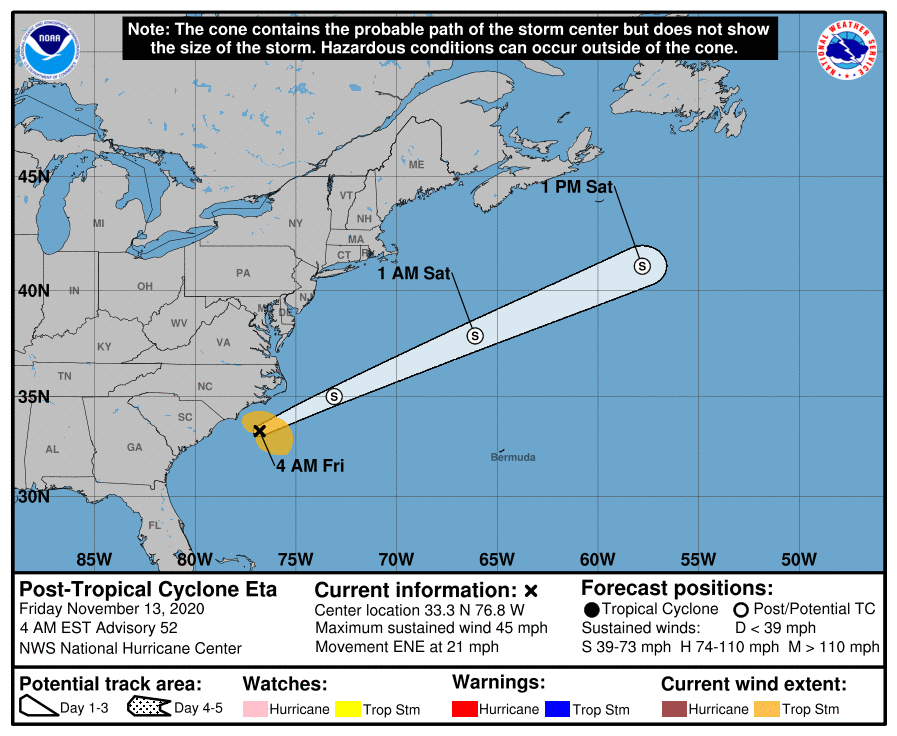Tropical Storm “Eta” brings deadly floods to Florida and North Carolina, U.S.

Tropical Storm "Eta" made its second landfall in Florida and overall fourth landfall at 09:20 UTC (04:20 LT) on Thursday morning, November 12, 2020, with winds of 85 km/h (50 mph), causing torn off trees and roofs, widespread flooding, at least one casualty, and power outage that affected 11 000 customers. Hours after pounding the state, it spread heavy rains and gusty winds around the Carolinas, resulting in record-breaking floods in Charlotte, multiple rescues, at least one collapsed bridge, and at least 6 fatalities. The overall death toll is now approaching 300.
On Thursday morning, Eta made its overall fourth landfall and second Florida landfall near Cedar Key, with winds of 85 km/h (50 mph), according to the National Hurricane Center (NHC).
Up to 152 mm (6 inches) of rain fell over central and northern Florida into Thursday morning. Officials in several areas– including St. Petersburg, Sarasota, and Madeira Beach have responded to reports of flooded streets and torn off roofs.
Roughly 11 000 customers lost access to electricity. As of Friday morning, November 13, a total of 616 customers remain without power, according to poweroutage.us.
After reaching the mainland, the winds fell to 64 km/h (40 mph) in the afternoon. The storm ripped roofs apart, caused flooding, and widespread outages that affected 11 000 customers.
In the south St. Petersburg Beach area, the Pinellas County Sheriff’s Office deployed its High Water Rescue Teams to save 33 people trapped in their houses and streets.
In Manatee County, one person lost his life after being electrocuted while standing in an inundated area prior to the landfall, emergency management officials said. Deputies and highway crews are still working to clear debris from roads.





In the Carolinas, moisture from Eta combined with a cold front moving eastward across the Eastern U.S. generated extremely heavy rainfall. At least 6 people lost their lives in North Carolina.
In Alexander County, North Carolina, authorities reported three bodies at a flooded campground about 97 km (60 miles) north of Charlotte on Thursday morning. Meanwhile, 31 people were rescued from the Hiddenite Family Campground and two people are still missing. In Rolesville, a child drowned in a flooded creek.
Alexander County Sheriff Chris Bowman said the campground is near a fast-rising river, which previously seen evacuations amid intense rainfall.
"That’s exactly what happened last night and this morning," he said, adding that it had been years since a storm brought so much water at once on the region.
Another person died in a vehicle accident near the Vashti community after one bridge in the county was swept away by "major flooding," as described by officials.
Alexander County director of public services Doug Gillespie reported that intense rains overnight left 50 roads compromised in the county.
Heavy rains also caused Little Sugar Creek to reach a record level of 4.5 m (15 feet), passing the marker set by Hurricane "Danny" in 1997, according to Charlotte Agenda.








Eta made its first landfall south of Puerto Cabezas, Nicaragua, on November 3, with maximum sustained winds of 220 km/h (140 mph)– a Category 4 hurricane strength.
It weakened into a tropical depression as it headed northwestward into Honduras before turning northwestward back into the Caribbean from November 4 to 5.
The country's banana sector has been hit particularly hard as more than half of the country's existing 15 000 ha (37 000 acres) has been lost to severe floods– the biggest damage in history for bananas, according to producers.
On November 7, Eta re-strengthened into a tropical storm and made landfall in south-central Cuba on November 8. It then made landfall in the Florida Keys on November 9 as it headed west and then southwest into the Gulf of Mexico.
Eta has left about 290 people dead or missing in Central America and the United States.
At 09:00 UTC (04:00 LT) on Friday, November 13, Eta became an extratropical low. At the time, its center was located about 135 km (85 miles) SE of Wilmington, North Carolina.
It had maximum sustained winds of 75 km/h (45 mph) and a minimum central pressure of 1 004 hPa.
Swells generated by Eta will continue affecting portions of the southeastern United States coast today. These swells are likely to cause life-threatening surf and rip current conditions.


Image credit: NHC
Featured image: Tropical Storm "Eta" at 09:20 UTC on November 13, 2020. Credit: NOAA/GOES-East, RAMMB/CIRA

Commenting rules and guidelines
We value the thoughts and opinions of our readers and welcome healthy discussions on our website. In order to maintain a respectful and positive community, we ask that all commenters follow these rules:
We reserve the right to remove any comments that violate these rules. By commenting on our website, you agree to abide by these guidelines. Thank you for helping to create a positive and welcoming environment for all.